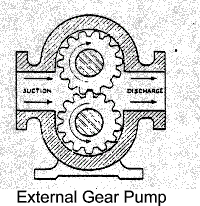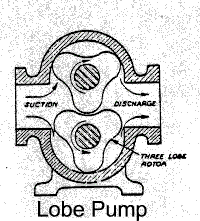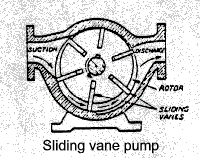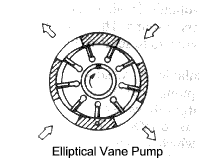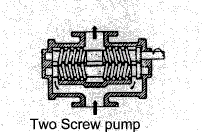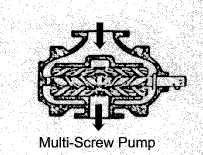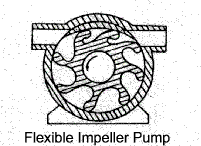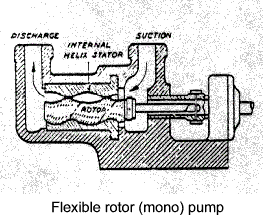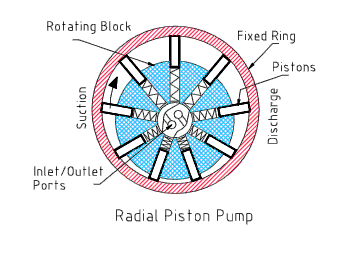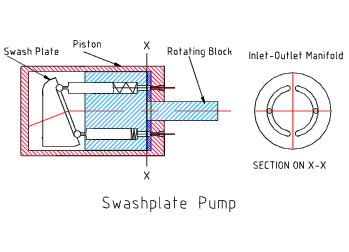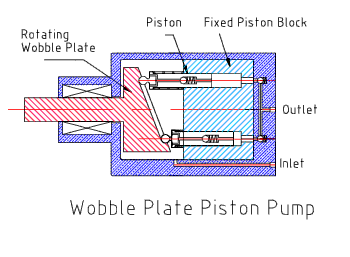Fluids Index
Back to Pumps Positive Displacement Pumps
|
Positive Displacement Pump Duties Fluid Transfer Duties when used in the medical area , chemical processing, domestic and industrial water supply, fire fighting , heating and cooling fluids, food and beverages, petro-chemical products, pharmaceutical products, sewage and effluents etc. Power Transfer Duties
when used for high pressure oil and water for brakes, servo
mechanisms, hydraulic motors, and aeroplane controls When used for descaling plant , high pressure water jetting ,
concrete cutting etc..
Below are identified various types of positive displacement pumps with notes identifying
operating information. The gear pump is used for fluid transfer and power transfer and process duties. The gear
pump is widely used in the agricultural and mobile vehicle industry for hydraulic
transmission systems.
Internal Gear Pump The internal gear pump has similar characteristics to the external gear pump. The pump has improved suction and delivery characteristics and is smoother in operation. The pump is based on an external gear located within and meshing with a larger internal gear. A crescent vane is included to seperate the inlet volume from the discharge volume between the two gears. The internal gear pump is however more complicated and expensive to manufacture and maintain. The internal gear pump can develop liquid pressures of 200 barg. Note: Gerotor pumps very similar to internal gear pumps without the vane . The operation of tyhe gerotor pump is similar to that of an internal gear pump. The inner gear rotor (gerotor element) is power driven and draws the outer gear rotor around as they mesh together. This forms the inlet and outlet discharge pumping chambers between the rotor lobes. The tips of the inner and the outer lobes make contact to seal the pumping chambers from each other. The inner gear has one tooth less than the outer gear, and the volumetric displacement is determined by the space formed by the extra tooth in the outer gear.
Lobe Pump This pump is based on two parallel rotors located within a shaped case.
The rotors include a number of lobes these are arranged such that as the rotors are
rotated they contain spaces which increase and reduce in volume.
Fluid enters these spaces through the inlet connection and is trapped as the rotors
rotate. The fluid is compressed and forced out of the discharge connection
as the rotor continues to rotate. This pump is effectively a development of
the external gear pump.
Sliding Vane Pump The vane pump includes a ring mounted inside a cylindrical case The ring
includes a number of radial slots in which are located sliding vanes. The ring
is mounted eccentric to the case and the vanes are designed to press against the inside
wall of the case. The vanes are forced against the wall by hydraulic pressure or
spring force or due the the centrifugal force resulting as the ring is rotated.
Multi- Screw Pump These pumps are used in the chemical process industry and in the oil industry for applications on oil rigs.
They are used for pumping fuel oil, lubrication oil, sea water, paints etc...
These pumps are relatively expensive and are not conveniently maintainable.
Peristaltic Pump This pump is based on a elastomeric tube through which the process fluid is forced.
The fluid is forced along the tube by the action of a number of lobes
or rollers which progressively squeeze along the length of the tube.
The tube should be closed by at least one lobe/roller at throughout the pumping cycle.
The squeezing items are generally located on the rotating support which
is drivern by a variable speed drive. This system includes no glands and
is very spooth operating.
The flexible impeller pump is low cost unit comprising of one moving parts.. The performance of this pump is directly
related to the material and design of the flexible impeller material. Neoprene is often used as a vane material.
Helical rotor/ Mono Pump This highly innovative pump includes a stator (case) having a two start helical cavity which
mates with the rotor which rotates and creates and internal void which progresses along the
stator. The stator is normally made from an elastomeric material such as nitrile.
The rotor material is selected for the process duty includes carbon steel and
stainless steel. The stator is often coated with wear-restant metal.
Rotary Piston Pumps This general type of pump includes a number of variations some of which are described below.
The pumps are extensively used for power transfer applications in the off shore ,
power transmission , agricultural, aerospace and construction industries,.. to list just a few.
All of these pumps work on a similar principle. Radial Piston pumps include a rotating cylinder containing equally spaced radial pistons
arranged radial around the cylinder centre line. A springs pushes the pistons
against the inner surface of an encircling stationay ring mounted eccentric to the cylinder.
The pistons draw in fluid during half a revolution and drive fluid out
during the other half. The greater the ring eccentricity the longer the pistons stroke
and the more fluid they transfer.
Swashplate Pumps. Swashplate pumps have a rotating cylinder containing parallel pistons arranged radially around the cylinder centre line.
A spring pushes the pistons against a stationary swash plate located at one end of the cylinder ,
which sits at an angle to the cylinder. The pistons draw in fluid during half a revolution and drive fluid out
during the other half. The greater the swashplate angle relative to the cylinder centre line the further the
longer the pistons stroke and the more fluid they transfer.
Wobble Plate Pumps. This pump includes a stationary piston block containing a number parallel pistons arranged radially
around the block centre(at least five). The end of each piston is forced against a rotating
wobble plate by springs. The wobble plate is shaped with varying thickness around its centre line and thus as it rotates
it causes the pistons to reciprocate at a fixed stroke.
The pistons draw in fluid from the cavity during half a revolution and drive fluid out
at the rear of the pump during the other half. The fluid flow is controlled
using non-return valves for each piston.
Bent Axis Pump. Bent axis piston pumps have a rotating cylinder containing parallel pistons arranged radially
around the cylinder centre line. The cylinder is driven by an shaft which is arranged at an
angle to the cylinder axis. the shaft includes a flange with a mechanical connection to each
piston. As the shaft rotates the pistons are made to reciprocate over a stroke
based on the relative angle of the shaft and cylinder.
|
Useful Links
|
|
